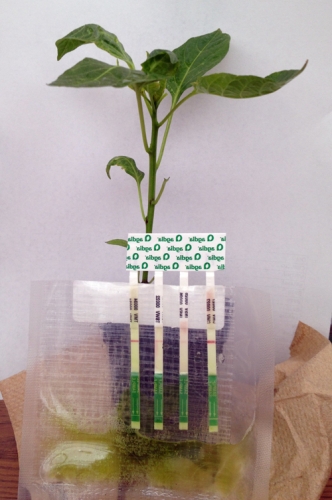Questioning a virus in your greenhouse crop?
A quick and simple test to determine if your crop has four common viruses.
The article on reacquainting yourself with tobacco mosaic virus that was published by MSU Extension on January 11, 2012, is a good article to help you identify symptoms associated with tobacco mosaic virus. The symptoms may include yellowing of the foliage, necrotic leaf spots, mosaic symptoms, stunting and leaf distortion. I look at the description and I can associate other plant problems to those symptoms such as insects, nutrition, diseases, etc. The point I am making is, you may have to consider several potential causes.
 In spring
production of annuals and perennials, there isn’t a great amount of time to
guess as to what is causing this plant problem. MSU’s Diagnostic Services understands the
urgency of determining an accurate diagnosis of the problem, but sometimes it
takes several days from the time the sample is received in the lab for the type
of tests they have to perform. So what I want to share with you is a test that
you can do yourself in the greenhouse as more of a first-response when the
issue is first noticed. I used the Agdia ImmunoStrip®
on a few different crops that had leaf distortion, necrotic leaf spots and
yellowing of the foliage that all are similar to virus symptoms. The kit detects
four viruses, tobacco mosaic virus, cucumber mosaic virus, impatiens necrotic
spot virus, and tomato spotted wilt virus, which are commonly associated with
the greenhouse plants we grow. These tests are about $14 a piece, so make sure
you follow the directions. Even with the directions I had a problem with it not
showing the control lines, meaning the test was invalid. The problem was me.
In spring
production of annuals and perennials, there isn’t a great amount of time to
guess as to what is causing this plant problem. MSU’s Diagnostic Services understands the
urgency of determining an accurate diagnosis of the problem, but sometimes it
takes several days from the time the sample is received in the lab for the type
of tests they have to perform. So what I want to share with you is a test that
you can do yourself in the greenhouse as more of a first-response when the
issue is first noticed. I used the Agdia ImmunoStrip®
on a few different crops that had leaf distortion, necrotic leaf spots and
yellowing of the foliage that all are similar to virus symptoms. The kit detects
four viruses, tobacco mosaic virus, cucumber mosaic virus, impatiens necrotic
spot virus, and tomato spotted wilt virus, which are commonly associated with
the greenhouse plants we grow. These tests are about $14 a piece, so make sure
you follow the directions. Even with the directions I had a problem with it not
showing the control lines, meaning the test was invalid. The problem was me.
My mistake was submerging the test strip into the buffer liquid. The directions say to basically wet the bottom tip approximately 0.25 inches or less so the solution begins to wick up the test strip. You can see the solution moving up the test strip going under the green area. The green area is the most important part of the test. The buffer wicks up under the green where there is an indicator chemical that will react with the buffer and leaf extract. One line appearing indicates a negative result, as seen with the pepper I sampled. If two lines appear, that is a positive result, and no lines indicate there was a problem and it is an invalid result. The kits do come with directions and I followed them, however, I guess I submerged the strips. Oops!
Being equipped with tools that will help in your integrated pest management strategy should expedite determining the cause and your decision-making process to control the problem. I hope my mistake eliminates you from making the same.



 Print
Print Email
Email




